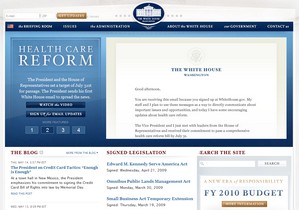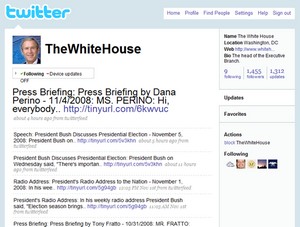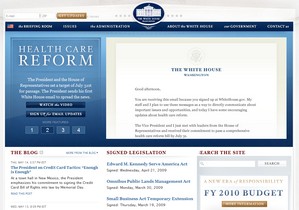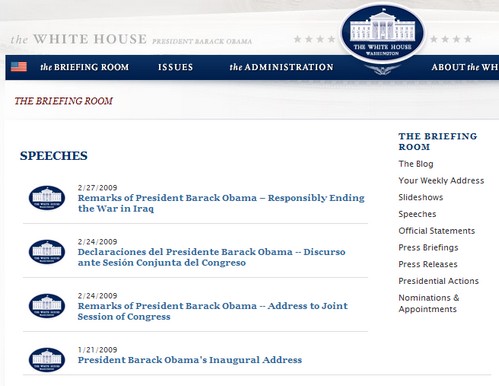Back in March, Jose Antonio Vargas from The Washington Post assembled a bipartisan group of five panelists to periodically review President Obama’s White House Website in a feature called “Grading WhiteHouse.gov.”
The group includes Craig Newmark of Craigslist.org; Andrew Rasiej, founder of the Personal Democracy Forum; Ellen Miller from the Sunlight Foundation; Jon Henke, a consultant and blogger for The Next Right; and David Weinberger, a fellow at Harvard Law School’s Berkman Center for Internet & Society.
 Due to the overwhelming response to the first column, Jose decided to add a guest reviewer for “Grading WhiteHouse.gov, Round Two,” which was posted earlier this week — and I was honored that he thought of me. Of course, he did indicate that he wasn’t going to be able to print my entire thoughts, but agreed to allow me to post them here.
Due to the overwhelming response to the first column, Jose decided to add a guest reviewer for “Grading WhiteHouse.gov, Round Two,” which was posted earlier this week — and I was honored that he thought of me. Of course, he did indicate that he wasn’t going to be able to print my entire thoughts, but agreed to allow me to post them here.
However, a few things to note before we start:
- The transition was absolutely flawless. President Bush’s site was archived and President Obama’s new site was officially launched on Inauguration Day right on time. I don’t think many truly recognize what a major accomplishment that was.
- It’s important to recognize that the Internet is still relaltively in its infancy and that social media is just a few years old. When I was at the White House, MySpace was all the rage, Facebook was still limited to those in college with .edu email addresses and Twitter hadn’t officially launched yet. Today, many are still trying to figure out what it means for business, the media and yes, even for our democracy.
- The Obama White House new media team, led by Macon Phillips, has only been in place a short time so let’s give them some room to settle in. They join a small fraternity of White House Internet staffers who came before them that built the foundation for what they will ultimately achieve. They are breaking new ground, trying new things and will certainly make some mistakes along the way. As technology and tools continue to improve, I know that they’ll get there, but it will just take time so let’s be patient. However, there are some basic things that seem to be missing, some of which are discussed in more detail below.
- I originally wrote this in late April just before the official 100 day mark — and about a week before the White House officially launched a presence on Facebook, Twitter, Flickr, etc. The first Obama White House email (on Health Care) just came out yesterday.
- These comments and opinions are purely my own and I’m very interested in your feedback. Feel free to weigh in at the bottom of the post.
So, in the spirit of transparency, the full transcript is provided below for your review.
Q: How would you define transparency? Accessiblity? Engagement?
There’s a whole lot of buzz about transparency these days, but I believe that there’s a lack of common understanding as to what it really means and how it should apply to the process of governing online.
In my opinion, the word “transparency” as it relates to government represents the ability for citizens to gain easy access to information surrounding the decisions and public activities of our elected officials. Clearly the Internet has assisted with this. People have more information available to them than ever before and this is one of the primary reasons why I refer to President Bush as the first “digital president” despite the fact that President Clinton was the first to launch a White House site. In the same way, President Obama will certainly build upon this progress as the Internet continues to expand.
However, most would agree that complete transparency for every communication, no matter how large or small, between federal employees poses unique challenges of its own, especially in our fast-paced, technology driven world.
Despite the sheer volume of content, privacy concerns, national security protections and political sensitivities, there are some technological hurdles, as well. For example, content must be universal to ensure that everyone can consume information equally including those without regular access to the Internet, on slower connections or using outdated equipment, browsers and plug-ins.
In addition, Section 508 of the Americans with Disabilities Act of 1990 requires that content on federal government Websites must be made available in different formats for those who may be hearing or sight impaired. There have been major strides in this area, including closed captioning options in YouTube, readable PDFs, audio/video tagging and other web-based software innovations which have leveled the playing field, most of which either didn’t exist, were restricted or too cost prohibitive to employ just a couple years ago.
Conversations that used to be one-way and constrained to “walled-gardens” on a handful of specific sites are a thing of the past thanks to social media. Now, when the White House publishes information, there is no shortage of online outlets where those issues can be discussed including social networks, news sites and blogs. The big question that still remains is whether the White House will use the Web to engage and better connect with citizens.
We saw the beginning stages of this under Jimmy Orr’s leadership (my predecessor) with the launch of “Ask the White House” in April 2003. By January 2009, the White House had hosted over 400 online chats via ATWH with officials from all areas and disciplines within the federal government, including one with President Bush aboard Air Force One in January 2008 on return from a Middle East trip.
President Obama broke similar ground with his “Open for Questions” event. Essentially, this was a standard live Webcast from the East Room where a handful of questions submitted via WhiteHouse.gov were answered in front of a pre-screened invited audience. It was reported that over 10,000 questions were sent in and I am hopeful that there will be many future opportunities to have those addressed in the coming months, as well, including live questions randomly selected from those who may wish to connect to the White House via real time video streaming technology such as Qik, Ustream or Skype.
 Q: In your mind, what’s the mission of WhiteHouse.gov?
Q: In your mind, what’s the mission of WhiteHouse.gov?
During White House events, President Bush often welcomed guests to the “people’s house” and I always viewed the Website in the same manner: WhiteHouse.gov is the people’s site — and it is one of a kind. Sure, other world leaders have similar sites but WhiteHouse.gov is the one place that users should be able to go to answer one simple Twitter-like question, “What is the president doing?”
I believe every American should have access to the activities of our president on any given day. For those looking beyond the sound bite to learn more about what is said and done on their behalf, the site serves an important role as a digital archive for unedited transcripts, photos, audio and long-form video of public events and press briefings.
In addition, WhiteHouse.gov should be a place where one can find more information about the president’s positions on current policy issues, as well as historical information about the American Presidency, the White House and the United States.
Q: What has surprised you most about Obama’s WhiteHouse.gov?
I was very impressed by the speed and efficiency of the transition when the White House team successfully managed the transfer and archival of President Bush’s site (including related multimedia) while simultaneously launching President Obama’s new version at 12:01 PM on Inauguration Day.
Load times are fast and the design is clean, crisp and modern. I am a fan of the rotating features which helps the user navigate the site based on relevant and timely issues. As an E-Gov evangelist, I was very pleased that President Obama chose to answer questions from WhiteHouse.gov for the East Room Webcast and the implementation of Google Moderator to manage the process was smooth and seamless. Also, the White House LiveStream has worked quite well since its launch. I specifically enjoyed watching the multi-stream coverage of the meetings on healthcare, as well as the continued tradition of the White House Easter Egg Roll Webcast.
Q: What has disappointed you the most?
As we know, this week marks 100 days since President Obama officially took office, (originally written in late April) so it is fitting to take a step back to examine some of the areas where the site still needs improvement now that his team has a few months under their belt.
My biggest disappointment with the new site is the difficulty I have in locating information due to poor organization architecture. Attempting to locate specific content is confusing and the structure is not intuitive. So much emphasis is placed on the blog that, unfortunately, related materials such as transcripts, photos, audio, video and links get lost, are buried or seem to be posted as an afterthought in separate, unrelated locations.
For example, the March 24, 2009 press conference was posted on the blog as, “Addressing Our Problems Head-On” and only included President Obama’s answer to a tough question posed by CNN’s Ed Henry which many thought was a highlight. The next morning, I still couldn’t find a transcript or video and when a link finally did appear a few hours later, it sent users to the Los Angeles Times blog. I’m sure the LA Times executives (and the blog’s advertisers) appreciate the increased site traffic from a taxpayer funded site, but shouldn’t WhiteHouse.gov – and ultimately the National Archives – be the permanent source for that information? What happens if the LA Times moves the transcript or starts charging for archived content on their site? In all fairness, I did eventually find the transcript a day or so later after several attempts via the search engine, but it wasn’t easy.
This isn’t an isolated situation. Since I couldn’t find a daily listing of presidential activities, I went to the Speeches section of WhiteHouse.gov under “The Briefing Room” and found only three (one in Spanish) currently listed. At the time of this post, the most recent listed is from 2/27/2009, “Remarks of President Barack Obama – Responsibly Ending the War in Iraq.”
Similarly, it is unclear as to how the items listed in Official Statements differ from speeches which have remarks mixed in with written statements from President Obama, Mrs. Obama and Vice President Biden – which are all separate from Presidential Actions such as executive orders, proclamations, etc.
Q: As it stands, what grade would you give the site? And give your one paragraph explanation.
Although the new WhiteHouse.gov has an attractive, modern design and a number of new features, it is still in its infancy and it is important to remember that. However, in some ways, the site seems to actually have less content than its immediate predecessor.
Simple things that were standard on President Bush’s Website such as daily press briefing video (which is on YouTube now, but not embedded or otherwise available on WhiteHouse.gov), Cabinet member photos and bios and RSS feeds for all remarks, weekly addresses, briefings and other releases (not just selected items) all seem to be missing. Given this, combined with the site’s organizational challenges, delayed postings and hard to find information, I have to give it a current grade of: C
I am confident that the Obama team will eventually fix these issues and ultimately take WhiteHouse.gov to the next level as the Internet also continues to grow and evolve. More importantly, users will help shape the site’s future by expecting the White House to add new functionality by providing more data, finding ways to incorporate social media, offering mobile versions of the site, adding text messaging and soliciting feedback from citizens on important legislation, thus improving the transparency of, access to and engagement with their government.
Related
Grading WhiteHouse.gov, Round Two (Jose Antonio Vargas, The Washington Post)
Grading Whitehouse.gov, Part 2 (Jon Henke, The Next Right)
Your Government & New Media (Macon Phillips, The White House)



Jamie Holts
Great post. I will read your posts frequently. Added you to the RSS reader.
Craigslist Proxy
Craigslist is such a popular site nowadays. That is good coz you can get stuff or read stuff as shown here, but sometimes you have the bad things like that news and the murders recently.
Zane Perry
I just posted a link to this story on the official “Whitehouse” facebook page. I wonder where that message will go :/
Zane Perry
I agree with your assessment on Whitehouse.gov. The media center is located @ http://www.whitehouse.gov/slideshows/ and the word media isn’t even on the front page.
There should be a big button or image for media. There should also be a handicap button for those who can’t read micro font.
This all of course is coming from an Obama fan 🙂